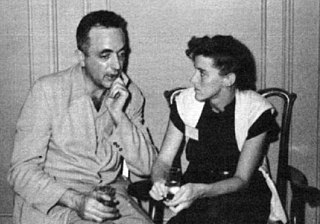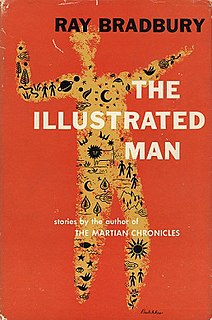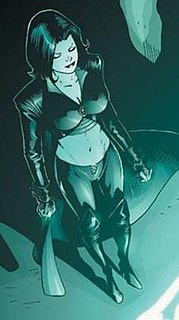
The Man with a Thousand Names is a short science fiction novel by Canadian-American writer A. E. van Vogt. It was published in August 1974 by DAW Books, and in December 1975 by Sidgwick and Jackson.

The Man with a Thousand Names is a short science fiction novel by Canadian-American writer A. E. van Vogt. It was published in August 1974 by DAW Books, and in December 1975 by Sidgwick and Jackson.
The main character is Steven Masters, a spoiled 23-year-old who happens to be the only son of the world's richest man. At a party he (while drunk) states that he wishes to go on a proposed space flight to a distant life bearing planet called Mittend. Mittend is 30 light years from Earth and is the closest life bearing planet. When he is told that he does not qualify, he gets indignant and sets upon a campaign to join in the expedition. Using his father's money he is able to get passage. Six weeks later he arrives on the planet. It turns out to be very similar to Earth, with a breathable atmosphere.
Upon landing he wanders off from the main group and meets the natives. The natives turn out to be naked and primitive but have a powerful group mind named "Mother". The natives, upon seeing Steven, chase after him and when they catch him and touch him, his mind gets traded into the body of a 38-year-old bar waiter back on earth. The bar waiter's mind gets transferred to Steven's body on the other planet.
It turns out that the bar waiter used to work for Steven as a butler. Steven blamed him for a crime he did not commit and got him fired. Immediately after the transfer, he goes into psychological shock and the bar is forced to call an ambulance. They sedate him and he has to spend a few days in the hospital. His story (of being mind swapped) gets out and combined with the fact the expedition has gone missing, he becomes a sensation. While in the hospital, Masters Senior (his father) comes to visit him. He leaves stating that the person there is not Steven. Upon leaving the hospital, he gets picked up by the bartender who drives him to work. He works the day.

Katherine Anne MacLean was an American science fiction author best known for her short fiction of the 1950s which examined the impact of technological advances on individuals and society.

Fictional representations of Mars have been popular for over a century. Interest in Mars has been stimulated by the planet's dramatic red color, by early scientific speculations that its surface conditions might be capable of supporting life, and by the possibility that Mars could be colonized by humans in the future. Almost as popular as stories about Mars are stories about Martians engaging in activity away from their home planet.

The Martian Chronicles is a 1950 science fiction short story fixup by American writer Ray Bradbury, which chronicles the colonization of Mars by humans fleeing from a troubled and eventually atomically devastated Earth, and the conflict between aboriginal Martians and the new colonists. The book lies somewhere in between a short story collection and an episodic novel, containing stories originally published in the late 1940s in science fiction magazines. The stories were loosely woven together with a series of short, interstitial vignettes for publication.

The Illustrated Man is a 1951 collection of eighteen science fiction short stories by American writer Ray Bradbury. A recurring theme throughout the eighteen stories is the conflict of the cold mechanics of technology and the psychology of people. It was nominated for the International Fantasy Award in 1952.

The Foundation series is a science fiction book series written by American author Isaac Asimov. First collected in 1951, for thirty years the series was a trilogy: Foundation, Foundation and Empire, and Second Foundation. It won the one-time Hugo Award for "Best All-Time Series" in 1966. Asimov began adding new volumes in 1981, with two sequels: Foundation's Edge and Foundation and Earth, and two prequels: Prelude to Foundation and Forward the Foundation. The additions made reference to events in Asimov's Robot and Empire series, indicating that they were also set in the same fictional universe.

Out of the Silent Planet is a science fiction novel by the British author C. S. Lewis, published in 1938 by John Lane, The Bodley Head. Five years later it was published in the U.S.. Two sequels were published in 1943 and 1945, completing the so-called Cosmic Trilogy or The Space Trilogy.

Shadow Lass is a fictional comic book superheroine appearing in books published by DC Comics. She first appeared in Adventure Comics vol. 1 #365, and was created by Jim Shooter and Curt Swan.

Protector is a 1973 science fiction novel by American writer Larry Niven, set in his Known Space universe. It was nominated for the Hugo in 1974, and placed fourth in the annual Locus poll for that year.

Fictional representations of the planet Venus have existed since the 19th century. Its impenetrable cloud cover gave science fiction writers free rein to speculate on conditions at its surface; all the more so when early observations showed that not only was it very similar in size to Earth, it possessed a substantial atmosphere. Closer to the Sun than Earth, the planet was frequently depicted as warmer, but still habitable by humans. The genre reached its peak between the 1930s and 1950s, at a time when science had revealed some aspects of Venus, but not yet the harsh reality of its surface conditions.

Prisoners of Power, also known as Inhabited Island, is a science fiction novel written by Soviet authors Arkady and Boris Strugatsky. It was written in 1969 and originally published in the same year in the literary magazine Neva. It appeared in a book form in 1971, with great number of changes as demanded by the state censor; the English translation was released in 1977. The protagonist is a youngster from Earth, Maxim Kammerer, who gets stranded on an unknown planet named Saraksh.

Not of This Earth is an independently made 1957 American black-and-white science fiction film produced and directed by Roger Corman, that stars Paul Birch, Beverly Garland, Morgan Jones, William Roerick, and Anna Lee Carroll. The film was written by Charles B. Griffith and Mark Hanna and was distributed by Allied Artists Pictures Corporation as a double feature with Attack of the Crab Monsters. Its theatrical release had a running time of 67 minutes, that was expanded to 70 minutes in 1962 for TV syndication.
In the fictional universe of the Stargate franchise, the people of Earth have encountered numerous extraterrestrial races on their travels through the Stargate. In addition to a diversity of alien life, there is also an abundance of other humans, scattered across the cosmos by advanced aliens in the distant past. Some of the most significant species in Stargate SG-1 are the Goa'uld, the Asgard, and the Replicators. Stargate Atlantis, set in the Pegasus galaxy, introduced the Wraith and the Asurans. One of the most influential species in Stargate, the Ancients, have moved on to a higher plane of existence. For practical reasons of television productions, almost all of the alien and human cultures in the Stargate's fictional universe speak native English. Because of the time constraints of an hour-long episode, it would become a major hindrance to the story each week if the team had to spend a sizeable part of each episode learning to communicate with a new species.

Islands in the Sky is a 1952 science fiction novel by British writer Arthur C. Clarke. It is one of his earliest works. Clarke wrote the story as a travelogue of human settlement of cislunar space in the last half of the twenty-first century.

Deceit is an original novel written by Peter Darvill-Evans and based on the long-running British science fiction television series Doctor Who. It features the Seventh Doctor, Ace and Bernice. Also included is Doctor Who Magazine comic character Abslom Daak, in his first appearance outside DWM. A prelude to the novel, also penned by Darvill-Evans, appeared in Doctor Who Magazine #198.

The Face-Eater is an original novel written by Simon Messingham and based on the long-running British science fiction television series Doctor Who. It features the Eighth Doctor and Sam.

Battle of the Worlds is a 1961 Italian science fiction film directed by Antonio Margheriti. The film stars Claude Rains, Bill Carter, and Maya Brent.

Hexwood is a 1993 fantasy/science fiction novel for young adults. It is by British author Diana Wynne Jones.

The Universe Maker is a science fiction novel by American author A.E. van Vogt, published in 1953 by Ace Books as an Ace Double with The World of Null-A. It is based on the author's "The Shadow Men".

"The Colorful Character" is a science fiction short story by American writer L. Sprague de Camp, part of his Viagens Interplanetarias series. It was first published in the magazine Thrilling Wonder Stories in the issue for December, 1949. It first appeared in book form in the collection Sprague de Camp's New Anthology of Science Fiction, published simultaneously in hardcover by Hamilton and in paperback by Panther Books in 1953.
| This science fiction–related article is a stub. You can help Wikipedia by expanding it. |
| This article about a 1970s science fiction novel is a stub. You can help Wikipedia by expanding it. See guidelines for writing about novels. Further suggestions might be found on the article's talk page. |
| This article about a Canadian novel is a stub. You can help Wikipedia by expanding it. See guidelines for writing about novels. Further suggestions might be found on the article's talk page. |